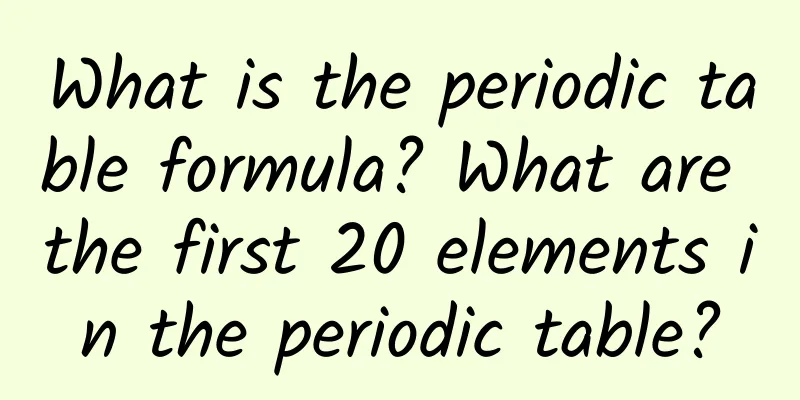What is the periodic table formula? What are the first 20 elements in the periodic table?

|
The periodic table of chemical elements is a list of chemical elements sorted from smallest to largest according to their atomic number. The list is generally rectangular, with spaces left in some periods so that elements with similar properties are grouped in the same family. In order to help people quickly memorize uncommon elements, a mnemonic for the periodic table was created. Let's read it together! Contents of this article 1. Periodic table formula 2. What are the first 20 elements in the periodic table? 3. In which region of the periodic table is iron located? 1Periodic table formulaThe mnemonics for the periodic table are: monovalent hydrogen, chlorine, potassium, sodium, silver; divalent oxygen, calcium, barium, magnesium, zinc; trivalent aluminum, tetravalent silicon, pentavalent phosphorus; divalent iron, trivalent iron, divalent carbon, tetravalent carbon; nitrogen from monovalent to pentavalent; divalent copper and mercury are the most common. There is also the periodic association memory method, which associates each element with words that are closer to our lives, making it easier to remember. Monovalent hydrogen, chlorine, potassium, sodium, and silver; divalent oxygen, calcium, barium, magnesium, and zinc; trivalent aluminum, tetravalent silicon, pentavalent phosphorus, divalent iron, trivalent iron, and divalent carbon; nitrogen is present from one to five valent; and divalent copper and mercury are the most common. Using this rhyming method of memory, you can quickly remember the chemical valence of each element. There is also periodic memory. The first period: hydrogen and helium, we can associate it with "invasion". The second period: lithium, beryllium, boron, carbon, nitrogen, oxygen, fluorine, and neon, we can associate it with carp skin holding carbon eggs and raising milk. The third period: sodium, magnesium, aluminum, silicon, phosphorus, sulfur, chlorine, and argon, we can associate it with the beautiful girl Guilin with green teeth. The fourth period: potassium, calcium, scandium, titanium, vanadium, chromium, and manganese can be associated with marrying, changing Kangtai, and becoming a counter-revolutionary; iron, cobalt, nickel, copper, zinc, gallium, and germanium can be associated with the iron aunt pinching the newly married woman; arsenic, selenium, bromine, and krypton can be associated with anger and shock. By following this memory method, you can quickly remember the periodic table. 2What are the first 20 elements in the periodic table?H hydrogen, He helium, Li lithium, Be beryllium, B boron, C carbon, N nitrogen, O oxygen, F fluorine, Ne neon, Na sodium, Mg magnesium, Al aluminum, Si silicon, P phosphorus, S sulfur, Cl chlorine, Ar argon, K potassium, Ca calcium. The periodic table of chemical elements is a list of chemical elements arranged from smallest to largest according to atomic number. The list is generally rectangular, with spaces left in some periods so that elements with similar properties are grouped in the same group, such as alkali metals, alkaline earth metals, halogen elements, and rare gases. This results in the formation of element partitions in the periodic table and is divided into seven main groups, seven sub-groups, group VIII, and group 0. Because the periodic table can accurately predict the properties of various elements and the relationships between them, it is widely used in chemistry and other scientific fields as a very useful framework for analyzing chemical behavior. 3In what region of the periodic table is iron located?Iron is located in the fourth period of the periodic table, group VIII. Iron is a metallic element with an atomic number of 26 and a chemical formula of Fe. Pure iron is white or silvery white with a metallic luster. It has a melting point of 1538°C and a boiling point of 2750°C. It is soluble in strong and medium-strong acids but insoluble in water. Iron has 0-valent, 2-valent, 3-valent, 4-valent, 5-valent and 6-valent states, of which 2-valent and 3-valent states are more common, while 4-valent, 5-valent and 6-valent states are less common. Iron is widely distributed in our daily life, accounting for 4.75% of the earth's crust, ranking fourth after oxygen, silicon and aluminum. Pure iron is a silvery-white metal with good ductility and flexibility. It is used to make the iron core of generators and motors. Iron and its compounds are also used to make magnets, medicines, inks, pigments, abrasives, etc. It is one of the so-called "black metals" in industry (the other two are chromium and manganese) (In fact, pure pig iron is silvery white. The iron element is called a "black metal" because the surface of iron is often covered with a protective film whose main component is black ferroferric oxide). In addition, the human body also contains iron. The divalent ferrous ion is an important component of hemoglobin and is used for oxygen transportation. |
<<: What are the main languages spoken in North America? Characteristics of North American rivers
Recommend
How about DAZA Winter Piano Keyboard Eyeshadow Palette? Review of DAZA Winter Piano Keyboard Eyeshadow Palette
Spring is coming soon, and girls who stay at home...
Why is female urine red?
The human body is carrying out basal metabolism, ...
Can I sleep with bare legs during confinement?
Because the birthing process will cause great dam...
Is it normal to stop menstruating at 40?
As we all know, women will gradually enter menopa...
What are the harms of prostatitis to women?
Prostatitis is likely to cause complications in w...
Do you yawn during early pregnancy?
It is very easy to have this or that problem afte...
How long does it take for the wound to stop hurting after a caesarean section?
Caesarean section is a common method of delivery,...
What to do if you get pregnant again after a miscarriage
I once saw a true story about a young couple who ...
Hepatitis C is an easily overlooked liver killer! It can easily develop into advanced liver cancer. How can we prevent it?
Primary liver cancer is one of the common maligna...
Why sour boy and spicy girl?
Sour boy and spicy girl is a folk rumor in real l...
Live broadcast|Hypothyroidism in the elderly cannot be ignored
Hypothyroidism (abbreviated as hypothyroidism) is...
There is a lump in the nipple that is painful when pressed
The symptom of a hard lump on the nipple and pain...
Castration, sex change... "drug girl" trapped in a man's body
In this world, besides men and women, there is al...
World Bicycle Day | Cycling regularly has so many benefits! But...
Today is World Bicycle Day . Cycling is a healthy...
Precautions and dietary taboos during the postpartum period
It takes about a month for the uterus to recover ...









